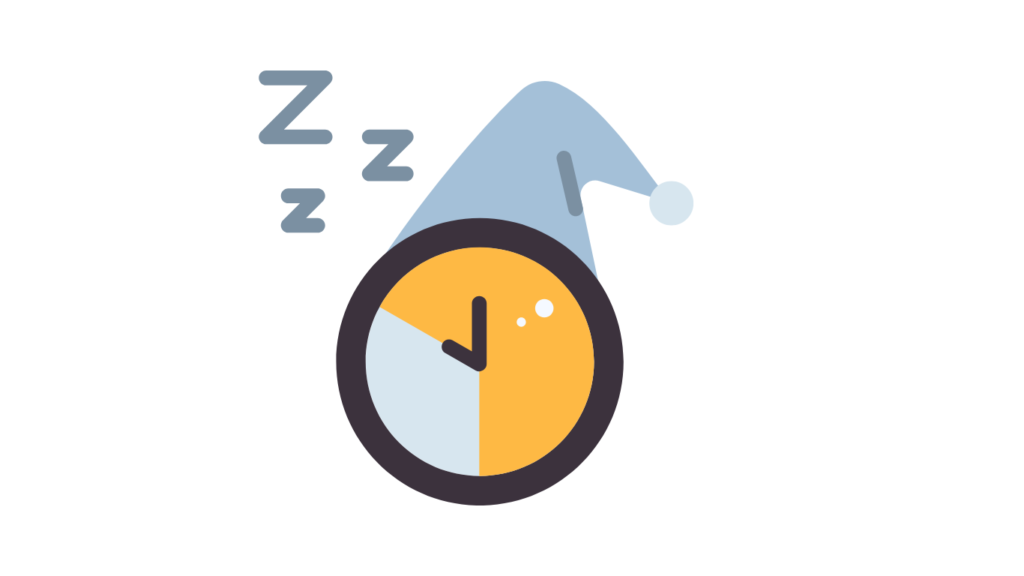Both adults and children need a regular sleep schedule in order to get healthy, restful sleep. It promotes better sleep, enhances general health, and assists in regulating the body’s internal clock. Creating a routine can have a significant impact, whether you’re an adult looking to better your personal sleeping patterns or a parent attempting to set up a sleep plan for your child.
Why is a Sleep Routine Important?
A sleep routine helps signal to your body that it’s time to unwind and prepare for sleep. By establishing a set series of activities before bed, your body learns to associate these behaviors with the transition into sleep. This creates a habit that your brain and body follow, making it easier to fall asleep and improve sleep quality over time.
- Improved Sleep Quality: A routine helps set the stage for better, deeper sleep, as your body knows when to prepare for rest.
- Reduced Sleep Anxiety: Knowing exactly when it’s time to sleep and what activities to do beforehand can help reduce anxiety and stress about falling asleep.
- Boosted Mental Health: Consistent sleep routines support emotional regulation, reducing mood swings and stress.
- Better Physical Health: Adequate sleep plays a crucial role in supporting immune function, heart health, and muscle recovery, all of which are enhanced by a regular sleep routine.
Sleep Routine for (0-12 Months)

For newborns ages 0 to 12 months, establishing a regular and caring sleep schedule is essential to their healthy growth and sleep habits. A healthy sleep schedule gives your infant the tools they need to fall asleep on their own and stay asleep for extended periods of time. Important components such as waking windows, tummy time, face time, and promoting self-soothing can have a big impact on your baby’s sleep and guarantee that they are emotionally and physically ready for sleep. Here’s how to include these routines into your infant’s everyday schedule.
Encourage Self-Soothing
From the age of 4-6 months, babies begin to develop the ability to self-soothe, which is an important skill for long-term sleep success. Self-soothing is the ability for babies to calm themselves down and fall back asleep without the need for parental intervention. To encourage self-soothing, try these tips:
- Put Baby Down While Drowsy, Not Fully Asleep: Try laying your baby down when they are drowsy but not completely asleep. This gives them the chance to learn how to fall asleep independently, which is essential for future sleep cycles.
- Use a Comfort Object: If your baby is old enough, a small, soft toy or blanket can provide comfort and reassurance, allowing them to self-soothe.
- Avoid Picking Up Right Away: If your baby wakes up in the night or fusses, give them a few minutes to see if they can settle themselves before picking them up. Over time, this can help them learn to self-soothe and fall back asleep on their own.
Wake Windows
Wake windows refer to the amount of time your baby is awake between naps or before bedtime. The right wake window is crucial for maintaining a healthy sleep routine. If your baby is kept awake for too long, they may become overtired, making it harder for them to fall asleep. Conversely, if their wake window is too short, they may not be tired enough to sleep deeply.
- For Newborns (0-2 months): The wake window is typically short, around 45 minutes to 1 hour. Newborns need frequent naps throughout the day, and a short wake window helps prevent overstimulation.
- For Infants (2-6 months): At this stage, the wake window extends to 1.5 to 2 hours. Your baby may be able to stay awake longer without becoming overtired.
- For Older Infants (6-12 months): As your baby grows, their wake window can extend to 2 to 3 hours. Pay attention to cues like yawning or eye-rubbing to avoid overtiredness, which can result in difficulty falling asleep.
Adjusting the wake window based on your baby’s age and individual needs will help them develop a predictable sleep schedule and sleep more soundly at night.
Tummy Time
The growth of your infant is greatly influenced by tummy time. As you can have three to four short periods of tummy time each day (three to five minutes for a newborn), it can get longer as the baby gets older. It plays a significant part in encouraging healthier sleep in addition to strengthening their back and neck muscles. Your baby’s capacity to roll over, sit up, and eventually crawl will be supported by stronger muscles. Tummy time and sleep are related in the following ways:
- Encourages Healthy Development: During tummy time, your baby develops motor skills and physical strength, which makes them stronger and more self-assured. Additionally, these advancements facilitate their ability to find a comfortable sleeping position.
- Boosts Wakefulness: You should include tummy time in your baby’s wake windows. This positively exhausts them, increasing the likelihood that they will nod off when it’s time for bedtime or a nap.
- Minimize Flat Head Syndrome: Plagiocephaly, or flat areas on the head brought on by spending too much time on one’s back, can be avoided with regular tummy time. Promoting tummy time during the day can help you sleep better at night.
Face Time
Face time plays a important role in developing bonding between parents and babies. During face time, parents and babies engage in eye contact, smiling, cooing, and other forms of communication that strengthen the emotional connection between them. This bonding experience helps babies feel secure and loved, which is essential for their emotional development.
- Strengthens Social and Emotional Development: Babies learn emotional regulation through face-to-face interactions. Engaging with them in positive, loving ways throughout the day supports their sense of security, which can help them feel safe and calm when it’s time to sleep.
- Helps Your Baby Understand Cues: Face time also helps your baby understand the world around them. Smiling, cooing, and making eye contact helps them recognize your face and associate it with positive feelings, reducing potential stress or anxiety as they settle for sleep.
- Establishing Routine Cues: When you have a predictable routine, including face time, your baby begins to understand that bedtime is near. This association of certain activities with sleep-time cues can make bedtime smoother.
Sleep Routine for Kids
- Set a Consistent Bedtime
Children thrive on routine, and a consistent bedtime is key. Set a bedtime that allows your child to get the recommended hours of sleep for their age group. Sticking to a regular sleep schedule, even on weekends, helps regulate their internal clock, making it easier for them to fall asleep and wake up. - Create a Relaxing Pre-Sleep Routine
Establishing a calming pre-sleep routine helps signal to your child’s body that it’s time to wind down. Activities like reading a bedtime story, taking a warm bath, or listening to soft music can help them relax and prepare for sleep. - Limit Screen Time Before Bed
Exposure to screens from phones, tablets, or TVs can interfere with the production of melatonin, the hormone that regulates sleep. Limit screen time at least an hour before bed to ensure your child can drift off more easily. - Create a Comfortable Sleep Environment
Make sure your child’s bedroom is conducive to sleep. This includes keeping the room cool, dark, and quiet. Consider using blackout curtains, a white noise machine, or soft lighting to create a calm and peaceful atmosphere for sleep. - Include Sleep-Friendly Foods Certain foods can support better sleep for your child. High-carb foods like bananas, rice, and milk can promote relaxation and improve sleep quality. Bananas are rich in magnesium and potassium, which help relax muscles, while rice can boost serotonin production, aiding in better sleep. Milk contains tryptophan, which helps increase melatonin levels, promoting restful sleep. Nuts, especially almonds, provide magnesium to help relax muscles and encourage a peaceful night’s rest. Including these foods in your child’s evening routine can help them wind down naturally.
- Encourage Physical Activity During the Day
Active play during the day can help your child burn off energy and fall asleep faster at night. Just make sure not to schedule vigorous activities too close to bedtime, as they can have the opposite effect and energize your child.
Sleep Routine for Adults
- Establish a Set Sleep-Wake Time
Adults benefit from going to bed and waking up at the same time every day. A consistent sleep-wake schedule regulates your body’s internal clock and improves the quality of your sleep. Aim for 7-9 hours of sleep each night to maintain optimal health. - Create a Relaxing Pre-Sleep Ritual
Much like kids, adults also benefit from a winding-down routine before bed. Engage in calming activities such as reading, journaling, or practicing deep breathing exercises. These activities signal to your brain that it’s time to relax and prepare for sleep. - Limit Stimulants
Avoid caffeine, nicotine, or heavy meals close to bedtime. These stimulants can interfere with your ability to fall asleep and disrupt your sleep cycle. Instead, opt for a light snack like yogurt or a banana if you’re feeling hungry before bed. - Turn Off Screens
The blue light emitted by phones, tablets, and computers can disrupt your natural sleep cycle. Try to limit your screen time for at least an hour before bed. Instead, engage in a relaxing activity, such as meditation or stretching, to help you unwind. - Optimize Your Sleep Environment
Create a sleep-friendly environment by making your bedroom a peaceful haven. Keep it cool, dark, and quiet. Consider using blackout curtains, an eye mask, or a white noise machine if needed. Ensure your mattress and pillows are comfortable to promote better sleep quality. - Exercise Regularly
Regular physical activity during the day can improve sleep quality and help you fall asleep faster. However, avoid vigorous exercise close to bedtime, as it can stimulate the body and make it harder to wind down.
Conclusion:
A consistent sleep routine for kids and adults is essential to improve sleep quality and overall well-being. For kids, establishing a set bedtime routine, including activities like face time, tummy time, and following age-appropriate wake windows, helps promote emotional security and better sleep. For adults, prioritizing a consistent sleep schedule, optimizing the sleep environment, and managing stress through practices like yoga or meditation enhance the quality of sleep.
Incorporating these routines for both kids and adults encourages better emotional regulation, reduces anxiety, and helps the body naturally prepare for restful sleep. A well-established routine leads to improved mood, cognitive function, and overall health. By making sleep a priority, you create a solid foundation for physical and emotional well-being for all ages.
FAQs
- Does the wake window include feeding? Yes, feeding is often part of the wake window, especially for younger babies.
- Do babies naturally extend wake windows? Yes, as babies grow, they naturally extend their wake windows, but this should be adjusted gradually to avoid overtiredness.
- What’s the best sleep routine? A consistent sleep routine, with calming activities like face time for babies or meditation for adults, helps improve sleep quality.
- How can I help my baby develop good sleep habits? Establish a consistent bedtime routine and soothing sleep environment to encourage good sleep habits.
- What if my baby has trouble falling asleep on their own? Gradually encourage self-soothing by offering comfort in the crib without picking them up, helping them feel secure.






One thought on “Building a Sleep Routine for Kids and Adults: Positive Strategies for Better Sleep”